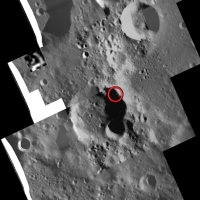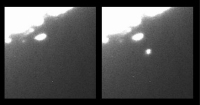SMART-1 latest maps for Kaguya's lunar impact
11 June 2009
Japan's lunar orbiter Kaguya yesterday concluded its successful scientific mission with a controlled impact on the lunar surface. The impact occurred at 18:25 UT on the Moon's near side, close to the limb, at lunar coordinates ~80.4°E and ~65.5°S. The location and time made the impact visible from Earth's southern hemisphere, and one early result has already been reported from the AAT telescope in Australia.Editor's note (17 June 2009): Observations have also been reported from Mount Abu Observatory, India. See "Kaguya impact observed from India" (right-hand menu) for further details.
 |
|
SMART-1/AMIE image of the lunar surface with the Kaguya impact point indicated. |
The impact marked the end of more than 18 months of operations in lunar orbit. Kaguya was launched on 14 September 2007 and upon arrival at the Moon entered a circular polar orbit with an altitude of ~100 km. Earlier this year, the orbit's altitude was lowered to perform observations at higher spatial resolution. Now, at the end of its available fuel and with a 2-tonne dry mass, the spacecraft has been sent spiralling down to the lunar surface.
The Kaguya spacecraft touched down on Wednesday 10 June at 18:25:13 GMT at the time planned by the project after a final orbit manoeuvre about one hour earlier. Dropping from an altitude of 7 km, the probe was just 1 km above the ground 1 minute before landing, as shown by the Kaguya altimetry data.
Europe's first lunar probe, ESA's SMART-1, also concluded its mission with a controlled impact on the Moon. SMART-1 impacted the lunar surface on 3 September 2006, having orbited the Moon since it was caught in its gravitational field in November 2004. The event was observed with ground-based telescopes and the flash from the impact was detected at infrared wavelengths.
Kaguya impact location
 |
|
AMIE image mosiac along Kaguya's impact ground trace |
The SMART-1 map shows that Kaguya's impact site lies within a much cratered ancient highland terrain. This meant that as the spacecraft sheared over the lunar surface around the points of closest approach (perilune) during its final orbits, the high topographic relief of the terrain played a role in where the exact final impact site would be. The incidence angle upon impact, determined by the spacecraft orbit and also the local slope of the lunar surface, affected the impact flash and the dynamics of the ejecta.
Observing conditions and early results
 |
|
AAT observations of the Kaguya impact flash. Credit: Jeremy Bailey and Steve Lee (AAT) |
After the event, the lunar surface at the site of impact now is a welcome subject for observations by future Moon orbiting missions that could obtain data of the area to compare it with pre-impact data, for example with the SMART-1 maps.
See also "Kaguya impact observed from India" (right-hand menu).
Editor's notes
Kaguya (also called SELENE, for SELenological and ENgineering Explorer) was launched by the H-IIA Launch Vehicle on 14 September 2007, at 10:31:01 a.m. JST (01:31:01 UT), from the Tanegashima Space Center in Japan.
Upon arrival at the Moon the orbiter released two smaller satellites in separate elliptical polar orbits: OKINA (a relay satellite for communications) and OUNA (a VLBI radio source satellite for supporting radio measurements).
Contact
Bernard H. Foing, ESA SMART-1 project scientist
Email: Bernard.Foing esa.int
esa.int
Bjoern Grieger, SMART-1 AMIE liaison scientist, ESAC
Email: Bjoern.Grieger esa.int
esa.int

